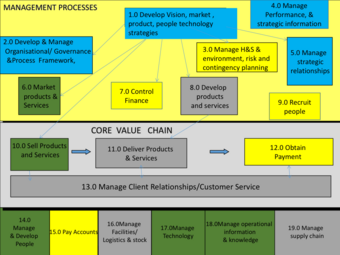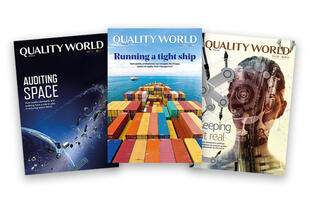
Leading a process-based organisation
Progress indicator

Sponsored article: Catalyst explores the role of a leader in establishing and maintaining a quality process in an organisation.
“If you can’t describe what you are doing as a process, you don’t know what you’re doing”. These words were spoken by the quality ‘guru’ W Edwards Deming. We realise that this is a controversial statement, that will either be accepted or not, depending on your definition of the word ‘process’.
We know, from discussing this word with many leaders, that the word ‘process’ can have negative connotations of bureaucracy and lack of flexibility. It is not universally accepted as a ‘good thing’. Have you ever heard the following expression from someone delivering a service to you? “I can’t provide what you want because the ‘process’ won’t allow it.” This is crazy and the very opposite of what a good process should provide.
So, why has process in some organisations got such a bad name? This article, looks at the leader’s role in relation to process, and why leaders should be interested and involved in establishing, maintaining, monitoring, looking after and caring about processes.
What is a process?
We define process as ‘the way work is done’. You might prefer to use the word ‘workflow’ which is somewhat easier to grasp. Workflow is used in video production, but we think it could have wider acceptability. For now though, let’s stick with the Lean Six Sigma accepted lingo and use the word ‘process’.
A process can be complicated, for example the process for making a Commonwealth Cocktail, which has 71 ingredients, or simple, like making a cup of tea.
In fact, all of the work done in organisations is delivered through processes. When we refer to processes, we do not mean that every process at every level needs to be documented, flowcharted or surrounded by measures. You wouldn’t do that for boiling an egg or travelling to work, would you? Similarly, in work, we believe that common sense should prevail. It is important for leaders to have a process mindset though, to monitor, review and improve the way their organisation operates. In other words, to be able to look at how work gets done in order to improve the way that it gets done. A process mindset is also helpful when it comes to measuring how well work gets done, and considering what are the most appropriate and sensible ways of monitoring the effectiveness and efficiency of work. Although we said that you wouldn’t want to surround your ‘non-work processes’ with measurements, you probably do ‘measure’ their effectiveness, but without consciously thinking about it as measurement. For example, how long did it take you to get to work? Were you on time or late? If late, how late? Is that cup of tea too hot or cold? Or is it just right?
Understanding what processes are and how we operate them is the key to efficient, effective and excellent ways of working. They give you the power to understand, challenge and improve the activities (any of the activities) within your organisation.
Creating a process architecture
Every organisation, no matter what size or sector, is made up of a system of processes that fit together. By recognising this, we can understand how activities link together and where there are dependencies. Taking a ‘process view’ can help people in organisations recognise the importance of being more connected in wider cross-functional teams. People can also become more connected with customers by understanding customers’ experiences of the organisation’s processes.
Yet while lots of organisations have defined individual processes, few will consider how the entire ‘framework’ of processes fit together. Try to describe your organisation on one page in a high-level picture of a set of ‘processes’, rather than the traditional organisational structure which describes how people are ‘managed’.
This is sometimes described as the ‘process architecture’ and has a number of advantages, such as:
- Aligning the work that gets done with business’ objectives. It’s easier to make links between what is done and what is required when looking at the organisation this way.
- Providing a structure for process-based operational measures.
- Allocating process ownership clearly to specific leaders.
- Providing a framework and clarity for the definition of processes at a more detailed level.
- Showing where people belong in the ‘big picture’ and how their work contributes to organisational success. People may know where to find their team in an organisation chart, but a process view allows them to understand the importance of what they do rather than where in the hierarchy they do it.
- Enhancing induction training. Everything your organisation does, and how it fits together, is shown on a page.
- Helping to understand the customers’ experience. Customers do not ‘see’ the products and services of an organisation through its organisational hierarchy; they see the outcomes of your organisation’s processes. They are not interested in who works for who.
- Distinguishing between core (customer facing) processes, support processes (‘enabling’ or back office processes) and management processes.
- Providing a view of process maturity and opportunities for improvement, which can be used to assist in improvement project selection.
Several iterations might be required before the process architecture that best represents the organisation can be agreed upon. As with most process definition work, brown paper and sticky notes can be helpful tools! When creating the picture, think about who to involve and engage in this task. Try to make sure the wording and terminology fit and match what’s used in other aspects of the organisation’s management system. People might not recognise what they do in the model, if it’s called something different. There’s no need for fancy terminology here, keep things simple and free of jargon wherever possible. For example, ‘manage strategic relationships’ might be better than ‘expedite and maximise collaborative synergies’!
Using a ‘verb/noun’ wording convention to name the process activities is also very helpful, eg, ‘collect stock’, ‘issue order’, ‘send confirmation’. This can prevent the process picture from getting too cluttered with words and labels.
Standing back and reviewing the picture for gaps and overlaps is the next step. Considering the start and end points of the processes can be helpful.
Sharing the picture with key stakeholders is a necessary step in building acceptance – several revisions may be made before the picture is agreed.
There is no ‘one best format’ for your process picture. It might change shape a number of times before the final version is arrived at. A live example is shown below. It’s actually how we run our own business at Catalyst and has stood the test of time for more than 10 years.
Process architecture of a professional services business

The process architecture might be made up of different types of processes.
|
Core value chain processes |
Processes that deliver the organisation’s products and services to its (external) customers. This is why the organisation exists. Everything else is here to either support or manage these core processes. |
|
Enabling or support processes |
Activities that allow the core processes to operate effectively. They cannot be described as ‘customer facing’ but do deliver services to internal customers. |
|
Management processes |
Processes such as planning and forecasting, leading business performance and managing change, that allow for effective steering and management of the organisation. |
The process architecture we are describing here is ‘high level’. Building in exactly how all of these activities are carried out, step by step within the same picture, would result in something very ‘busy’ and complex looking – not the desired effect.
About the article: This article was extracted and adapted for CQI’s Knowledge Hub from Lean Six Sigma for Leaders, by Martin Brenig-Jones and Jo Dowdall, Wiley Publishing 2018.
Learn more!
Visit Catalyst website to learn more about its services.
Quality World

Get the latest news, interviews and features on quality in our industry leading magazine.


